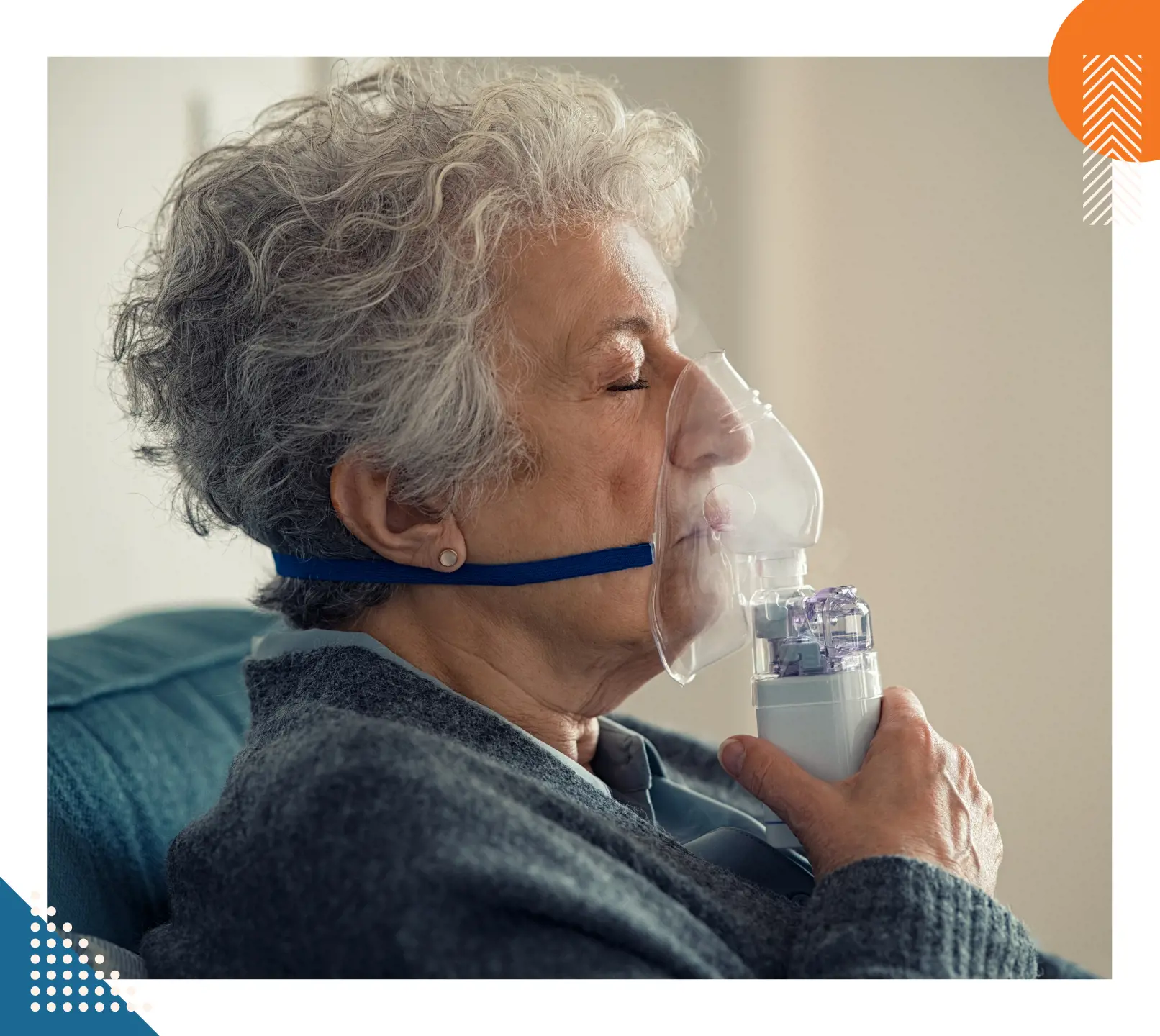Asthma is a common long-term lung condition that causes breathing difficulties due to inflammation and excess mucus in airways.
1 in 9 people in Australia have asthma, which approximates to 2.7 million people. It can happen to anyone, and it is important to recognise symptoms and access early treatment to prevent serious illness and hospital admissions.
Asthma can often run in families, and be related to other conditions, including eczema, hay fever and allergies.
People with asthma have sensitive airways that are more likely to react to triggers.
Common asthma triggers include:
-
Respiratory infections
-
Allergies to pollen, pets, smoke or dust mites
-
Weather changes
-
Physical activity
While asthma is a long-term health condition, for most people, asthma can be well-controlled by following a daily management plan.
Common Signs & Symptoms of Asthma
Wheezing
Wheezing is a high-pitched breathing sound that happens during an asthma flare up. It is caused by the narrowing of airways in lungs from inflammation, tightening of airway muscles, and increased mucous production.
When is wheezing a cause for concern?
Severe or persistent wheezing: This can indicate poorly controlled asthma. It can be a sign that your asthma medication regimen needs adjustment or ruling out other causes.
In summary, while wheezing is a common symptom of asthma, it is important to monitor its severity and frequency, and seek medical advice if it is suggestive of worsening asthma or accompanied by other worrying symptoms.
Shortness of Breath
Shortness of breath in asthma sufferers can present as difficulty in breathing out (exhaling), wheezing, chest tightness, increased work of breathing, cough and fatigue.
The increased effort to breathe during an asthma flare up can present as rapid breathing - to take in more oxygen or increased use of neck and shoulder accessory muscles to move air in and out of lungs.
These symptoms can often be triggered by various activities and situations. Commonly, these include:
-
Allergen exposure: pollen, dust mites, animal dander & mould
-
Irritants: tobacco smoke, air pollution, strong odours (perfumes and cleaning products), and chemical fumes
-
Physical activity
-
Weather: cold air, changes in weather and high humidity (thunderstorms)
-
Respiratory infections: common colds, flu and sinus infections
-
Emotional stress
-
Medications: beta-blockers & NSAIDs
-
Medical Conditions: Gastro-oesophageal reflux disease
Chest Tightness
Chest tightness in asthma is often described as a feeling of pressure in the chest. This happens due to the narrowing of airways, leading to difficulty in breathing and overuse of chest muscles.
It can significantly affect daily activities and overall quality of life in people with asthma. Poorly controlled asthma results in difficulties with engaging in physical activities including exercise and sports due to fear of triggering symptoms. It can also lead to disrupted sleep due to nocturnal symptoms, and subsequently, daytime fatigue.
Further, frequent asthma flare-ups can lead to missed days at work or school. The constant fear of an asthma attack can lead to stress and anxiety and can contribute to feelings of depression and helplessness. Finally, asthma can co-exist with other health conditions such as allergies, reflux and obesity, complicating management and affecting overall health.
Coughing
Coughing is a common symptom of asthma and has certain characteristics. Asthmatics usually experience a dry cough due to irritation and inflammation of airways, where mucus or phlegm is not brought up.
The cough is typically worse at night or early mornings and is regulated by circadian rhythm, supine position and cooler air. It is triggered by exercise or environmental factors such as exposure to airway irritants such as pollen, pets, dust mites, mould, tobacco smoke or air pollution.
Often the cough is associated with wheezing. If not properly managed, the cough can be persistent, lasting for weeks or even months.
Symptoms of an Asthma Attack
Asthma symptoms can range from mild to severe. It is important to be able to distinguish between typical asthma symptoms and those that indicate an asthma attack. Asthma attacks, also known as acute exacerbations, require immediate medical attention.
An asthma attack is a sudden and severe worsening of asthma symptoms. It can be life-threatening and needs prompt medical intervention.
Symptoms of an asthma attack include:
-
Severe shortness of breath: Marked difficulty in breathing - even when at rest, rapid, shallow breath, and inability to speak in full sentences
-
Severe wheezing: Loud and persistent wheezing that does not improve with usual medications
-
Continuous coughing: Can be uncontrollable and debilitating, and may produce mucous
-
Severe chest tightness: Worsened feeling of constriction and pressure in the chest. This can also accompany chest pain
-
Cyanosis: Bluish discolouration to lips or face is often suggestive of insufficient oxygen in blood. This indicates emergency medical attention.
-
Rapid decline in Peak Flow Reading: A significant drop in peak expiratory flow rate (PEFR) measurements usually indicates worsening airway obstruction
What are silent symptoms?
Silent asthma symptoms refer to subtle or less obvious signs that can often go unnoticed. However, it is important to note that these symptoms still indicate underlying inflammation and airway obstruction related to asthma.
What do silent symptoms look like?
-
Mild difficulty in breathing, usually noticeable with physical exertion
-
Frequent throat clearing
-
Fatigue
-
Vague chest discomfort
-
Poor exercise tolerance
How do we manage silent symptoms of asthma?
-
Trigger avoidance: Identify and avoid known triggers. Control environmental exposures
-
Regular monitoring: Peak flow meter - to measure lung function regularly. A decline in PEFR can indicate worsening asthma. A symptom diary can help track subtle symptoms and potential triggers
-
Asthma action plan: This is a personalised plan that details your asthma medications and how to use them. Routine medication reviews are important to prevent symptom progression and complications. Good medication compliance and inhaler technique allows your medications to work at their best to help you feel better.
Understanding when Asthma Symptoms are triggered
Asthma symptoms can be triggered by various activities and situations. Commonly, these include:
-
Allergen exposure: pollen, dust mites, animal dander & mould
-
Irritants: tobacco smoke, air pollution, strong odours (perfumes and cleaning products), and chemical fumes
-
Physical activity
-
Weather: cold air, changes in weather and high humidity (thunderstorms)
-
Respiratory infections: common colds, flu and sinus infections
-
Emotional stress
-
Medications: beta-blockers & NSAIDs
-
Medical Conditions: Gastro-oesophageal reflux disease
Recognising Asthma Symptoms in Children
Asthma in children can present differently to adults. This makes it all the more important for parents and carers to recognise specific symptoms suggesting asthma. As children may find it challenging to express how they feel, it is essential to look out for signs and symptoms suggestive of asthma.
Classic signs of asthma include:
-
Frequent coughing, which can be worse at night, during exercise, or when laughing
-
Rapid breathing
-
Shortness of breath
-
Wheezing
-
Chest tightness
-
Drawing in of the chest wall
-
Nasal flaring
More subtle signs or “clues” suggestive of asthma include:
-
Fatigue
-
Recurrent respiratory infections that seem to linger longer than usual
-
Increased irritability
-
Poor appetite or weight loss
As children may have difficulty articulating their symptoms, parents and family play a vital role in recognising early signs of asthma. By carefully observing their child’s behaviour and patterns, parents can identify potential triggers and seek appropriate medical attention.
As parents and carers for someone with asthma, you can help monitor breathing patterns, keep a symptom diary, observe for any behavioural changes, and ensure regular medical check ups.
When to See a Doctor
Signs That Require Immediate Attention
It is crucial not to ignore severe asthma symptoms, as these can escalate quickly and become life-threatening. Seek emergency medical attention if you have any of the following symptoms.
-
Your symptoms get worse very quickly
-
Severe shortness of breath
-
Unable to speak comfortably
-
Lips look blue
-
Confusion or loss of consciousness
-
Get little or no relief from your reliever inhaler
If you believe you have Asthma
If you or your child has not yet been diagnosed with asthma, but presents the following symptoms, it is important to see a doctor for diagnosis and treatment plan for possible asthma.
-
Frequent coughing, especially at night or during physical activities
-
Shortness of breath
-
Wheezing
-
Chest tightness or pain
-
Recurrent respiratory tract infections
Your doctor can offer lung function tests, allergy tests and other investigations as needed to diagnose asthma.
Regular Monitoring and Check-ups
Regular medical check ups, and maintaining a symptom diary are essential to manage asthma effectively. These visits allow for:
-
Monitoring lung function
-
Assessing the effectiveness of current treatment regimen
-
Preventing flare ups
-
Adjusting medications as needed
-
Education and support
Managing Asthma Symptoms
Medication and Treatment Options
There are two main types of asthma medications: relievers and preventers.
Relievers are used to quickly ease asthma symptoms, but should not be overused. Preventers are taken daily to reduce inflammation in airways and prevent asthma flare ups. Both these types of medications are usually inhaled, but can also be tablets.
Most asthma medicines are inhaled using a device called an inhaler or puffer. To ensure the medication reaches the lungs effectively, proper technique is essential.
-
Choose the right device: The type of inhaler depends on the medicine, age, lung function, ease of use, and personal preference.
-
Get appropriate training: Always seek guidance from a healthcare professional on how to use your inhaler correctly.
-
Use a spacer: A spacer can improve the delivery of medication to the lungs, especially for children.
-
Cleanliness: New spacers should be washed before use, and all spacers should be kept clean.
-
Rinse mouth: After using certain medications, rinsing your mouth can help prevent side effects.
By following these guidelines, you can maximise the benefits of your asthma medication and improve asthma control.
Most adults with asthma need both relievers and preventers, while many children only need relievers. The specific treatment depends on the severity of asthma symptoms.
It is important to consult with a doctor to determine the best course of treatment for you and discuss potential side effects.
Lifestyle Adjustments and Preventative Measures
Lifestyle changes can greatly assist in reducing the frequency and severity of asthma symptoms.
Here are some ways in which lifestyle changes can optimise your asthma management:
Avoiding asthma triggers
Identify and avoid your specific asthma triggers. Common triggers include:
-
Allergens: dust mites, pet dander, mould and pollen
-
Irritants: smoke, air pollution, strong odours and chemicals
-
Weather changes: cold air or dry air
-
Exercise
Creating a healthy environment by maintaining smoke free environments, ensuring good ventilation, regular cleaning, and controlling humidity.
Maintaining a healthy lifestyle.
Regular exercise can be beneficial for overall lung health. Maintaining a healthy, balanced diet to optimise your nutrition, weight management, stress reduction, and adequate sleep, likewise, can improve your asthma outcomes.
It is also important to be up to date with your yearly flu vaccinations, follow your doctor's advice regarding regular use of medications, and remembering to always carry your reliever inhaler.
Asthma Action Plan
An asthma action plan is a personalised guide to managing your asthma.
It outlines how to prevent asthma attacks, recognise early warning signs of worsening asthma, manage asthma symptoms, and to act quickly if symptoms worsen.
Having a written action plan helps you and your family know what to do in different asthma situations. It is essential to review and update your asthma action plan regularly, especially if your symptoms change or worsen.
An effective asthma action plan is a cornerstone of asthma management. It empowers you to take control of your condition and reduce the risk of severe asthma attacks.
Asthma Action Plan by National Asthma Council Australia
Sources:
Asthma Australia: https://asthma.org.au/
Therapeutic Guidelines Australia: australianprescriber.tg.org.au
Sydney Children’s Hospital Network: https://www.schn.health.nsw.gov.au/asthma-factsheet
Queensland Children’s Hospital: https://www.childrens.health.qld.gov.au/health-a-to-z/asthma
Better Health Victoria: www.betterhealth.vic.gov.au














































